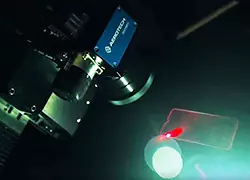What Exactly Is Motion Control?
Motion control is a specialized field within automation engineering that focuses on the coordinated, controlled movement of mechanical systems. At...
Work with our team to determine which products or systems are the best fit for your application.
Some Aerotech products are available for immediate order in North America through our partner Motion Plus.

A case study examining display production that optimizes quality and throughput – and lower total cost.
A motion control device is an electronic system component central to modern automation. It is responsible for managing and executing machinery’s controlled physical movement. This discipline, which focuses on governing the velocity, acceleration, position and torque of mechanical systems, is foundational to industries ranging from robotics to semiconductor manufacturing.
When movement tolerances are tight and repeatability is paramount, these components form the backbone of precision motion control, the specialized engineering field that drives the highest levels of automated performance globally. Understanding the function of these individual devices is key to optimizing any automated process.
A motion control device is an electronic system that manages the movement of machinery or equipment with high determinism. At its most fundamental, it comprises an integrated set of hardware and software designed to translate a high-level digital command—such as moving a tool along a complex path—into a physical, repeatable mechanical action. These systems orchestrate the core components:
Motion controller (the brain)
Servo drive (the neurons)
Motor (the muscles)
Feedback sensor (the eyes)
By constantly processing data within a closed loop, the system ensures the actual movement aligns perfectly with the intended movement profile. These devices are crucial in precision automation, inspection and manufacturing processes, where errors measured in microns can lead to significant material waste or product failure. Motion control devices are essential for precise movement and positioning required by advanced applications like laser processing, microscopy and high-speed pick-and-place machines.
A motion controller is not the same as a PLC (Programmable Logic Controller), though they often interface and work collaboratively within a single machine architecture. The primary function of a PLC is to manage overall machine logic, safety interlocks, sequencing and discrete Input/Output (I/O)—essentially, controlling the machine's state (e.g., "is the door closed?" or "turn the pump on"). In contrast, the motion controller is specialized for the mathematically intensive task of controlling movement, which includes:
Generating high-resolution motion profiles
Executing interpolation (e.g., generating a circular path from a few points)
Performing real-time, high-speed closed-loop servo updates (often at 20 kHz or faster)
While some modern PLCs now incorporate motion control functionality, a dedicated motion controller offers superior bandwidth, advanced algorithms (like feedforward and dual-loop control) and more axes of control needed for high-performance applications. The motion controller differs from PLC in functionality and application, with the controller focusing on kinematic performance and the PLC focusing on sequential and safety logic.
Motion controls regulate the speed, position and acceleration of motors and actuators in an automated system. Their fundamental role is to enforce the desired motion profile across all axes simultaneously. This is achieved through the control loop, which uses algorithms to constantly calculate and correct the difference between the target position (the command) and the actual position (the feedback). Specifically, motion controls manage:
Positioning: Ensuring the final mechanical position is accurate and repeatable, often within nanometer tolerances.
Velocity Control: Maintaining constant speed or following precise acceleration/deceleration ramps to minimize vibration.
Synchronization: Enabling complex movements and the synchronization of multiple independent axes (e.g., electronic gearing or coordination in a robotic arm).
By managing these parameters with high resolution, motion controls enable complex, multi-axis motion and synchronization in automated systems. Using the best motion control devices is paramount, as their inherent speed and advanced features enhance the overall efficiency and precision in demanding industrial operations.
The two primary electromechanical devices that form the command and power core in a modern closed-loop control system are the motion controller and the servo drive. The motion controller acts as the system's central command unit. It receives the high-level trajectory commands from the host computer or PLC and calculates the precise, time-stamped position and velocity commands needed for each motor axis. These low-power, digital commands are then transmitted to the servo drive.
The servo drive is the power amplification and conversion unit. It takes the controller's low-power command and converts it into a high-power, modulated current (typically using Pulse Width Modulation, often called PWM, or linear amplification). The servo drive then delivers this amplified current to the motor windings, controlling the motor's torque and movement. The system relies on the servo drive as a key component in motion control devices, as it is the final link that translates the controller's digital instruction into the required physical force needed to move the payload accurately.
Have questions about precision motion control? Ask our experts!
Motion control is a specialized field within automation engineering that focuses on the coordinated, controlled movement of mechanical systems. At...
Motion control programming is the process of writing the software instructions that define and execute automated machinery’s precise physical...